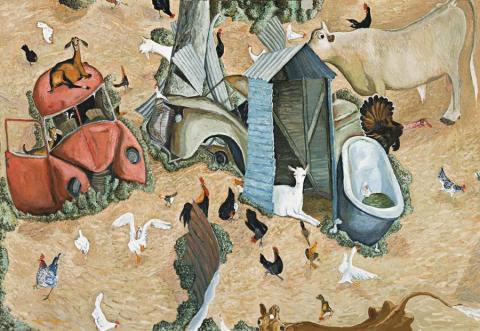CONSTRUCTION WITH WRECKS, DUNNY AND BULL, 1984
William Robinson
oil on canvas
137.0 x 198.0 cm
signed lower left: William Robinson
Ray Hughes Gallery, Sydney
Christopher Day Collection, Sydney
Private collection, Brisbane
William Robinson, Ray Hughes Gallery, Sydney, 1985
William Robinson, The Revelation of Landscape, National Trust S.H. Ervin Gallery, Sydney, 11 January—2 March 2003; Mornington Peninsula Regional Gallery, Victoria, 1 April—18 May 2003, cat. 2
Realms of Vision: The Art of William Robinson, William Robinson Gallery, Queensland University of Technology, Brisbane, 27 August 2009—22 August 2010
Fink, H., ‘Light Years, William Robinson & The Creation Story', in Seear, L. (ed.) Darkness & Light, The Art of William Robinson, Queensland Art Gallery, Brisbane, 2001, p. 25 (illus.)
Watters, J., William Robinson, The Revelation of Landscape, National Trust of Australia (NSW), Sydney, 2003, p. 10 (illus.)
Rainbird S., Realms of Vision: The Art of William Robinson, Queensland University of Technology, Brisbane, 2009, p. 37 (illus.)
William Robinson, in his farmyard scenes, delights in the unusual based on the everyday, as seen to perfection in Construction with Wrecks, Dunny & Bull 1984. What could be more prosaic than the backyard scene with a few chooks and ducks, a discarded bathtub, and a wooden dunny? Add a few goats, turkey, bull and cow, together with the wrecks of car bodies and you have the ingredients of the painting. The miraculous transformation into an absorbing work of art is achieved by a blend of whit and whimsy, including the unusual high viewpoint adopted, curious perspectives, fascinating rhythms, and humorous detail. The cow's eyes balance on the bottom edge of the picture. The white bull and the black cock seemed intent on eying each other off, and on it goes. Robinson's painting has all the fascinating detail that you find in a work by the great Netherlandish artist Pieter Bruegel the Elder. You never tire of reading it, and you discover something new on each return visit. It is the same with Robinson. Bruegel-like, the white goat sitting at the entrance to the dunny suggests some wise bucolic proverb or aphorism, while two white ducks add a touch of balletic beauty to all this busyness. Robinson's playful anthropomorphism is the hallmark of his humour. Somehow the two car wrecks take on human personalities 'perhaps a redhead in earnest conversation with one of grey? Meanwhile, the prominence given to the piece of corrugated iron in the centre foreground conjures up all kinds of responses without an answer. Perhaps of walls that divide and are torn down 'black chooks united with white ducks' amid the detritus of life. The absence of a horizon and tightness of composition create an intimacy that heightens the notion of backyard gossip. Profiles and frontalism are used to chatty effect. Yet, colours are amazingly lyrical as one happily overlooks the brilliant compositional order given to such disorder. For all its seeming haphazardness, the ordering is highly sophisticated, if not paradoxically elegant. Forms advance and recede as the picture plane opens up a world of wonderland in a spatial depth of its own. In this and other engaging paintings inspired by his farm at Birkdale, Robinson presents the epic comedy of life through that which surrounds him. As Lynn Fern observed in her monograph, these farmyard paintings 'are full of the wry humour of the townsman attempting to adapt to the life of the land.'1 It is a disarming part of their attraction.
1. Fern, L., William Robinson, Craftsman House, Roseville East, New South Wales, 1995, p. 43
DAVID THOMAS
